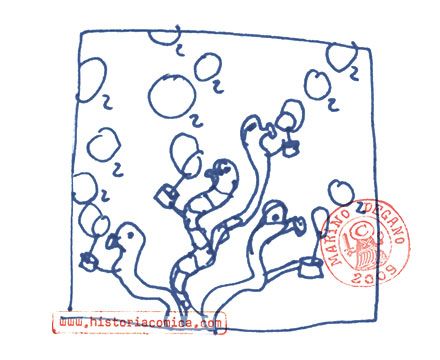PHOTOSYNTHESIS ~3,5 billion years (~3,8?)
Cyanobacteria, also known as blue-green algae, blue-green bacteria or Cyanophyta, is a phylum of bacteria that obtain their energy through photosynthesis. The name "cyanobacteria" comes from the color of the bacteria (Greek: kyanós = blue) . They are a significant component of the marine nitrogen cycle and an important primary producer in many areas of the ocean, but are also found in habitats other than the marine environment; in particular cyanobacteria are known to occur in both freshwater, hypersaline inland lakes and in arid areas where they are a major component of biological soil crusts.
Stromatolites of fossilized oxygen-producing cyanobacteria have been found from 2.8 billion years ago. The ability of cyanobacteria to perform oxygenic photosynthesis is thought to have converted the early reducing atmosphere into an oxidizing one, which dramatically changed the composition of life forms on Earth by provoking an explosion of biodiversity and leading to the near-extinction of oxygen-intolerant organisms. According to endosymbiotic theory, Chloroplasts in plants and eukaryotic algae have evolved from cyanobacteria via endosymbiosis. (click to see all the article on Wikipedia)
光合作用 ~35億年前(~38?)
藍綠藻,也被稱為藍綠菌,藍綠藻門,為細菌界中之一門,經由光合作用來獲取能量。藍綠藻這名稱是由其顏色而來(希臘文:kyanós = 藍色)。他們是進行海中氮循環的功臣,也是許多地區的海洋中,相當重要的生產者;尤其藍綠藻能夠在淡水中作用,在高鹽度的內陸湖和乾旱地區中,也存在於生物土壤結皮之中。
(譯者註:生物土壤結皮:廣泛分佈在世界的乾旱,半乾旱地區,在土壤中的分佈主要集中在表層4mm左右。它包含了微細的有機組成與土壤成分,並且二者是複雜交互作用下所形成的有機複合體。)
從疊層石中,找到的藍綠藻化石,證明其在28億年前製造氧氣。藍綠藻行氧光合作用,使得早期單純的大氣帶有氧氣,這重大的轉變使得初始的生命得以在地球上留存,而造成了日後爆炸性的生物多樣性,以及厭氧性生物的滅絕。根據內共生學說,植物中的葉綠體和真核藻類都源於內共生的藍綠藻。




 留言列表
留言列表

